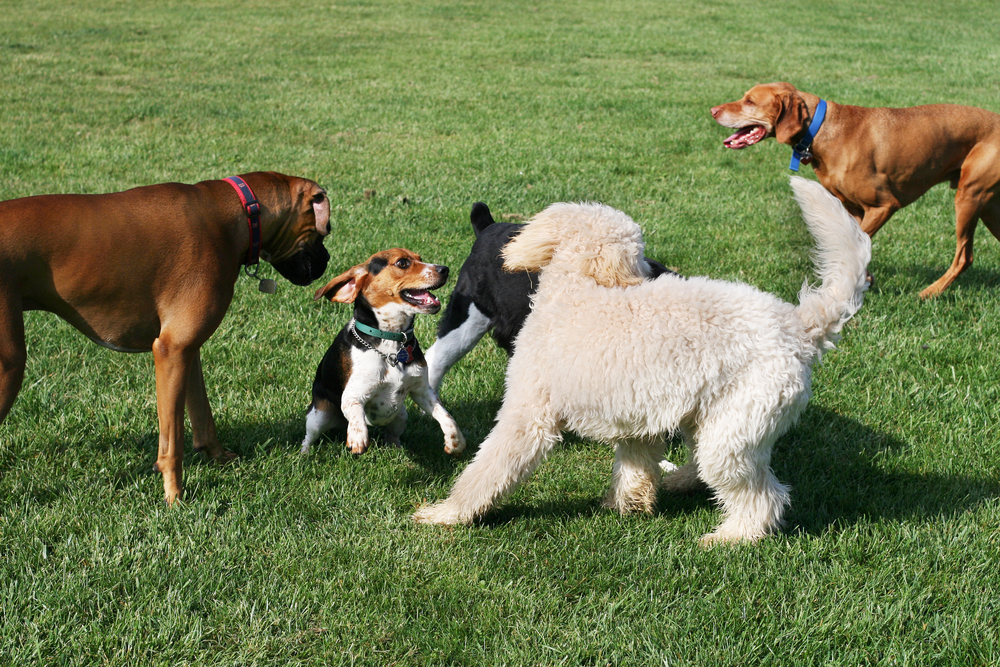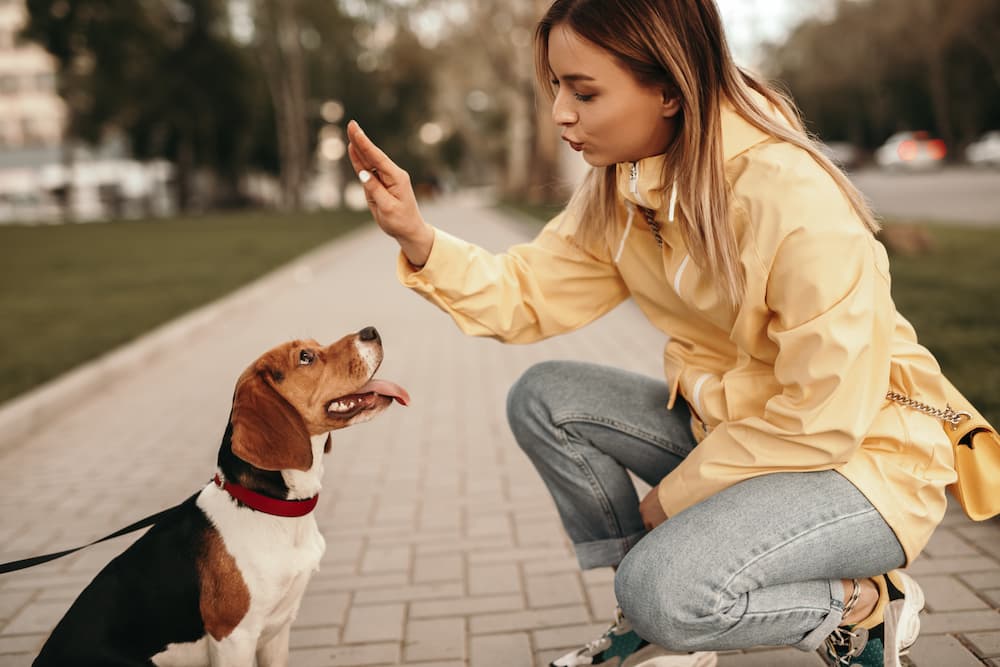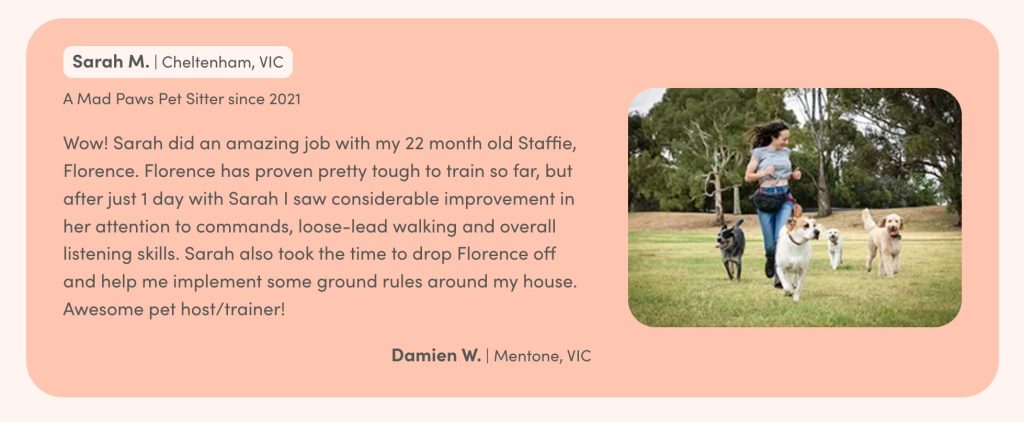The one thing that we Dog Owners want for our puppers is for them to be happy, comfortable, and confident in all situations! But, if you have a reactive dog, that might feel like a far-off reality for your pooch.
Whether they’re triggered by the sight of other dogs or spooked by loud noises, every outing can feel like you’ve got a ticking time bomb on the other end of the leash. What’s more, you might be limiting your dog’s outdoor time or hesitating to allow them to be walked by someone else because you’re worried about their behaviour. And that can make things even worse.
The good news is, you can work to lessen your dog’s reactivity with positive, humane training techniques. With the right reward system, intentional practice sessions, and lots of patience, you can convince your doggo that the world is a safe, inviting place to be. Here’s how to do it!
First, consider working with a certified dog trainer or animal behaviourist.
While reactivity is something that you can work on on your own, we highly recommend finding a professional who can help you through the process. Reactivity is stressful and potentially dangerous behaviour, so the safest and quickest route is to work with someone who has experience with reactive dogs!
If you do decide to work with a Dog Trainer or animal behaviourist, take your time to find someone you enjoy working with and who is committed to positive reinforcement training.
Before starting any training with your reactive dog:
Find your dog’s preferred reward system
Part of your work with your pup will be rewriting their relationship with their trigger with the use of treats, positive praise, or play. Over time, they’ll learn that instead of barking, lunging or growling at a passing dog or stranger, they can look to you for something good! This is called counter-conditioning.
So, really take time to figure out what gets your dog’s tail wagging. It might be a high-reward treat like boiled chicken or a special toy that they only get to play with during your training sessions.
Squeeze in a short exercise session before reactivity training
If possible, it’s a good idea to warm up your pup before training sessions with a little bit of play and exercise. This could mean a fun game of interactive tug or fetch in the backyard. Or, if you’re not able to dedicate time to both an exercise session and a training session, you might call in a friendly Dog Walker to take your doggo around the block a few times.
Keep in mind, of course, that you don’t want your dog to be exposed to their trigger right before your training session, as that could make them too stressed to continue. Instead, have the Dog Walker walk your pooch in an area without too many distractions.
Follow these tips with reactive dog training:
1. Work on desensitisation with plenty of distance
Once you’ve stocked up on your dog’s favourite treats, it will be time to start the desensitisation process. To do this, you’ll want to find your dog’s baseline for reactivity, or threshold. When your dog is under threshold, they will be able to see, hear or smell the trigger, but they’re still generally relaxed. You should be able to get their attention on you from time to time; in other words, they’re not fixated on the trigger.
The closer the trigger is, the more likely that your dog will become stressed and reactive.
Your goal will be to work just outside of your dog’s zone of reactivity and reduce that distance over time.
2. Reward your pup for calm behaviour
No matter if your dog is able to be a few metres away from their trigger or an entire city block away, you always want to reward calm behaviour. If your dog is able to hold a relaxed position and even check in with you to do a trick, show them that this is the behaviour you want from them!
Offer lots of praise and their favourite reward, and don’t be afraid to just sit and wait. Your dog is busy at work taking in information about their trigger and learning how to be in the presence of something scary or anxiety-inducing without reacting. In fact, they’re learning that seeing their trigger brings rewards!
3. Take plenty of breaks
During the desensitisation process, it can feel like you and your pup aren’t really doing much. But the truth is, there’s a lot going on in your dog’s brain! Even when seeing their trigger from afar, your pupper is gathering information about the world around them, making decisions about whether to react or stay calm, and picking up on cues from their beloved human. If you could take a look in that brain of theirs, you’d be astounded by how many chemical reactions are happening at the mere sight of their trigger.
That’s why it’s incredibly important to give your dog brain breaks throughout the desensitisation process. You might remove them to a quiet area where they can focus on a chew toy, or scatter some treats in the grass to practice scent work. These calming tasks will help reset your pup before trying again.
4. Gradually decrease (or increase!) distance
While it’s important to take time with this process, you’ll want to move your dog’s progress along by gradually nudging them closer to their trigger. Remember to always follow your dog’s lead. If they can only move a few centimetres closer before they start reacting, then that’s as slow as your progress needs to be.
On the flip side, there will be times when you need to increase the distance between your dog and their trigger. This can be frustrating, especially when you’re weeks into training! But it’s much better to take a few steps back proactively than risk flooding your dog. Remember also that you should never punish your dog for reacting to their trigger, as that could increase their anxiety and delay your training even longer.
In any training session with your reactive dog, remember:
Don’t overdo it
Your first reactivity training session can be short and sweet, only about fifteen to twenty minutes (or less depending on the severity of your dog’s reactivity) with a few breaks throughout.
One thing that you want to avoid is flooding your dog, or pushing your dog past their threshold before they’re ready. So, keep sessions relatively short, take breaks, and make sure your pup gets a nice long sleep between sessions so that their brain has the chance to make new neural pathways.
Stay consistent
If there’s one thing you might have taken away from this guide, it’s that working with a reactive dog takes time! Some Dog Owners may need to dedicate months and even years to lessening their dog’s negative reactions to certain stimuli. Others may be able to help their pup overcome their reactivity in a matter of weeks.
No matter how long it takes, it’s incredibly important to be consistent. The more frequent your successful training sessions are, the easier the process will be.
Remember that progress isn’t linear
Finally, we need to talk about Dog Owner burn-out! Dealing with a reactive dog is stressful, overwhelming, and sometimes scary! And there will be days when you feel like your dog is regressing back to their old ways.
Try to remember that progress isn’t a straight line, and deep down, your dog is benefitting from the work you’ve put in together. Stick with it and stay hopeful. Your dog trainer, vet, and dog-loving friends are rooting for you both!
Need someone to help deal with your reactive dog? |




1 comment
It’s so important that everyone one knows the value of early socialisation. I would not have socialised my dog until after he was fully vaccinated if not for a a school friend who had a degree in animal behavior and told me the importance of socialising before 4 months of age (carefully of course)
My boy is so unreactive that we can and do take him anywhere.
It’s amazing, everyone needs to know this.